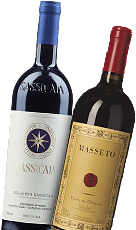
Tignanello Antinori
Tignanello Antinori wine stands out for excellence and quality, boasting a special relationship between passion and tradition: who doesn't know this masterpiece?
The history of the Valentini winery dates way back to 1600 when this family of noble origins already owned the estate of the same name in the province of Pescara that produced wine, oil and wheat.
Select Pairing
- Pairings
The Tignanello wine price, as for any great wine, is conditioned by various factors, first of all the year of production, but not only. Buying on Enoteca Properzio you’re sure to buy a quality bottle, impeccably preserved, so that it can be tasted at any time.
The vineyards that host these famous vines are the estates of the Marchese Antinori, which are located in the heart of Chianti, these soils enjoy unparalleled climatic characteristics. The careful and meticulous choice of grape varieties has certainly contributed to the fame of Tignanello wine. The result is an excellent super tuscan wine: Tignanello Antinori, capable of giving an unparalleled organoleptic experience.

Tignanello Magnum wine: a special format for unique occasions
This premium red wine is a sublime accompaniment to game dishes, as well as to aged cheeses, thanks also to the hints of chocolate and coffee. The level of tannins gives a dense and rich structure. In addition to the traditional format, for some vintages a Tignanello Magnum version was also produced, it’s a bottle suitable for a precious gift and to seal memorable moments.
Tignanello wine, the best vintages

This fine tuscan wine, produced with attention and care, is 'born' only when the climatic and environmental characteristics allow it. It’s also thanks to this choice that the quality and the name are maintained at the highest level, guaranteeing an often limited production.
What are the best vintages of Tignanello? Let's find out some of them together.
Tignanello 2015: this vintage saw a regular climatic trend and an equally stable harvest in the weeks between September and October. In this bottle in particular the hints of licorice and blackberry stand out.
Tignanello 2016: the climatic conditions of 2016 were really special and gave a few days earlier budding than usual. The grapes that give rise to this wine were harvested at different times. This award-winning vintage gave the wine notes of vanilla and spices, as well as hints of red fruits.
Tignanello 2017: a particularly cold winter and a hot summer favored a production characterized by balsamic organoleptic notes of mint and cloves.
Tignanello 2018: this wine has arrived at the tasting with its fantastic ruby color and the sweetness and elegance of the tannins.
Buying such bottles means investing in the taste and quality of a wine production that does not fear any comparison at an international level. It is no coincidence, moreover, that some of these productions have been - and continue to be - awarded both in Italy and abroad, continuing to garner the support and appreciation of all the public. You don't need to be an expert sommelier to be able to perceive all the splendor and excellence of such a product.

Over the years, the various members of the family worked in different activities, through to the start of the 20th century when Edoardo took over management of the estate and started to concentrate the family’s efforts on the production of top quality wines, especially Trebbiano and Montepulciano d’Abruzzo, which down to this day remain symbols of the Valentini wine family. This historic, ancient business is now led by Edoardo’s son, Francesco Paolo, who calls himself a “wine artisan”. This artisan has faithfully continued all he learnt from his father, managing, over the years, to produce the very same wine. Day after day, year after year, Francesco Paolo puts the same enthusiasm and energy into his work, saying that he is as in love with his wines as he was the very first day. The cornerstone of his management of the family business has always been to choose an artisanal method for processing the vines and the wine, respecting nature and allowing its fruits to freely emerge. This has led to the decision not to filter the wines, to use only the natural yeasts in the skins and not to control the cellar temperature.




 Red
Red 













